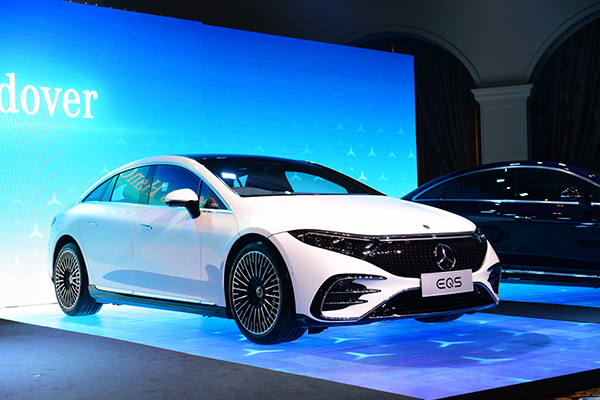Sales of Mercedes EQS luxury models plummet. Very high prices, inferior material quality compared to the S-Class, poorer rear access, and lack of a very fast charging 800V platform are the objective causes. Current Mercedes CEO Ola Kallenius was head of e-mobility development before being appointed to the top position as head of development and later CEO. What options does Kallenius have?

Mercedes has had a completely different strategy than BMW in terms of developing luxury electric models, opting for a dedicated electric platform, while the BMW i7/i5 is based on the conventional CLAR platform that also underpins the conventional 7 Series/5 Series models.
Essentially, a dedicated electric platform has several clear advantages: better aerodynamics with direct implications on energy consumption, better use of interior space due to a shorter front end (no front ICE engine taking up a lot of space), and a simplification in the production process as it has fewer components.
What has Mercedes done? In the case of the Mercedes EQS, the EVA II platform has exploited only part of the advantages offered by the dedicated electric architecture: a very good Cx of only 0.20 translated into decent energy consumption, even at motorway speeds, but less interior space in the rear than in the S-Class.
Where did Mercedes go wrong?
Material quality is inferior to the S-Class, and in the luxury segment, this matters a lot, especially in Europe. Also, the Chinese clientele is annoyed that access and knee room in the rear of the EQS are poorer than in the S-Class.
Wealthy Chinese don’t want to bump their heads when they get in the car and want to stretch their legs out in the rear without hitting the front seats with their knees. So, who was responsible for the EQS’s body shape? Mainly, design chief Gorden Wagener, but he’s not the only one who decided on the final shape. In the past, Wagener has made compromises regarding rooflines and you can see the GLE or GLC Coupe where functionality took priority over design. In the end, the last word belonged to Kallenius.
Electric program with a lot of problems
Kallenius can’t boast too many accomplishments during his time as head of e-mobility and deciding Mercedes’ electric model program. Built on a mixed platform with elements from the GLC, the Mercedes EQC was outdated in terms of range, battery technology, and charging speed when it came on the market, the EQA and EQB are nothing more than an electric adaptation of the GLA/GLB and the EQS which costs over 100,000 euros uses a 400V platform.
By comparison, the Kia EV6 and Hyundai Ioniq 5/6 have 800V platforms with much faster charging speeds and bi-directional charging. Renault for example, cooperates with Google and uses Google Automotive which automatically displays real-time charging station options when the battery drops below 20% and tells you like BMW what percentage of the battery you will reach your destination with.
The Porsche Taycan, which is in the same price range as the EQS, also has an 800V platform and a rear engine mated to a two-speed gearbox.
Last but not least, the design of the EQS is also criticized. On his Instagram account where he has over 500,000 followers, Wagener is ridiculed by members who compare the design of the EQS to volume brands. The EQS lacks the unique styling of a premium product like the S-Class.
Not least, the new MMA platform that will underpin future electric compact models is more modern than the EQS, using 800V technology. But it also doesn’t have bi-directional charging, Google automotive, or rare earth-free motors like BMW’s. Mercedes brags about reducing rare earth content, but it hasn’t been completely eliminated.
Plans to change the rear design
Mercedes has set up a task force trying to fix the EQS design flaws. It is trying to modify the rear-end design, but it is not easy. However, the modifications are mandatory because we are talking about the survival of the model. In addition, shareholder criticism of Ola Kallenius, who was in charge of the electric model program before being elected CEO, is mounting.
Today, Mercedes’ success is due to the C-Class, GLC, E-Class, and the AMG versions with conventional engines. Mercedes insists in its sales press releases on the success of electric models. 1,529,800 units were sold in the first nine months of 2023, of which only 160,300 were electric, 10% of the total. Of those, only 26,300 were EQS and EQS SUVs, while the S-Class, not counting the GLS, the conventional equivalent of the EQS SUV, is selling three times better despite an 18% drop in the third quarter of 2023.
In the same, according to investigation led by Automobilwoche , just 1,100 units of the EQS were sold in the USA in the third quarter of 2023, a decrease of 55 % compared to the previous quarter, while the S-Class sales increased by 47 % to 3,890 units.
German auto motor und sport magazine reports that Mercedes is trying to convince those who qualify for a company car to opt for an electric car. It is a good strategy in the short term, but it won’t secure the German brand’s electrified future.
Mercedes-Benz EQS Sales Have Dropped Dramatically
27/11/2023
No Comments
Mercedes-Benz | Mercedes-AMG
Click to rate this post
[Total: 1 Average: 5]